By John Silvester
It is pretty trendy now – the development that was once Pentridge Prison.
You wonder if the customers at the coffee shop just outside the imposing bluestone walls know or care about the brutality that went on for decades in what was Victoria's biggest jail.
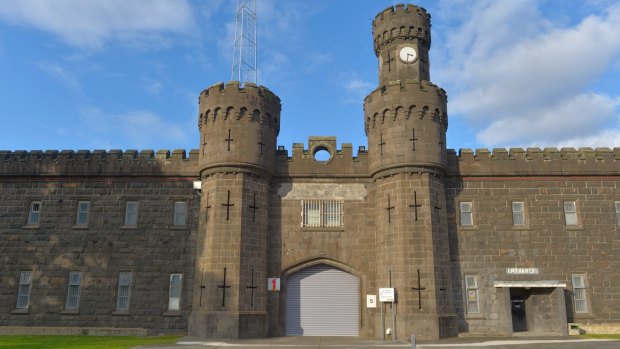
The former Pentridge prison.Credit: Michael Clayton-Jones
Down the bottom end was H Division, reserved for the baddest, the maddest and sometimes the meekest (it was used for protection as well as punishment).
As part of the redevelopment of the prime real estate the old labour yards were recently demolished – pens open to the weather where inmates broke rocks until 1976.
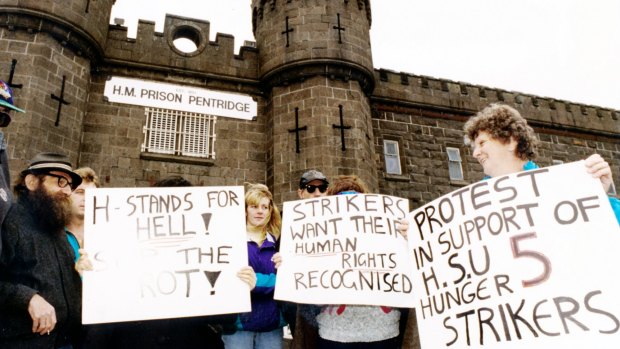
Support for hunger strikers in 1994.Credit: Michael Clayton-Jones
The place was rebuilt so often it did not resemble the original design and the developers have promised to rebuild a section to the original 19th-century specs.
The days of breaking rocks are long gone and anyone who still advocates "old-style" brutal punishment for inmates has rocks in their head.
If animals at the Melbourne Zoo were kept in such conditions there would have been mass protests but few ever saw what went on down in Hell Division.
New inmates learnt the first lesson on the way in. It was known as the "Liquorice Mile", where prison officers formed a guard of honour reception to beat prisoners (often naked) to the point of submission.
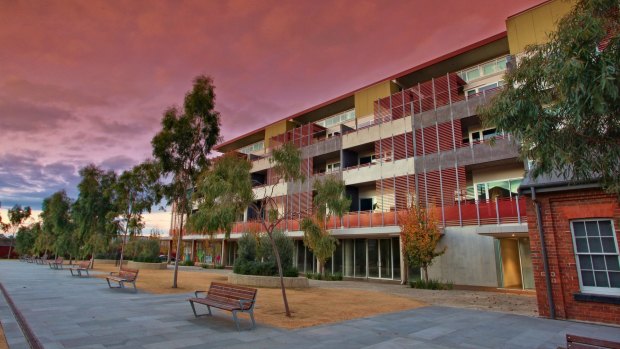
Pentridge Boulevard, Coburg
When Building Society bandit Greg "Doc" Smith arrived he was advised by standover man Mark "Chopper" Read to walk slowly and keep his head up to show hecould take the beating.
Strangely, both inmates became best-selling authors. Smith, also known as Gregory David Roberts, escaped and was recaptured 10 years later. His autobiographical novel Shantaram became a runaway success, much like "Doc" himself.
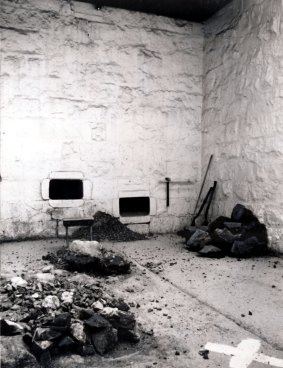
The labour yard of H Division in 1975.
Another who used the suffering to create was Ray Mooney, now an acclaimed playwright.
But many who ended up there were beyond redemption or the barbaric conditions made them so. It was the chicken and egg argument – leaving most of them either stuffed or scrambled.
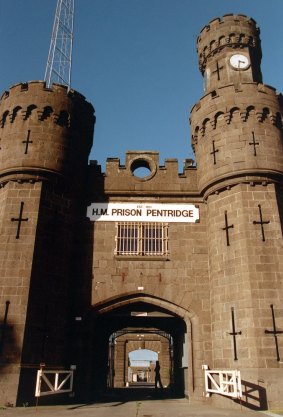
Pentridge Prison.
It was here in 1958 that police killer William O'Meally became the last man flogged with the cat-o'-nine-tails as a punishment.
Back in 1990 I went to H Division to interview long-term inmate "Chopper" Read after he complained about a critical profile I had written about him.
It was certainly nothing like the movies with a glass screen and a telephone link. We sat in a small room at the end of the division separated by a cheap table.
Read chatted and I took notes. The subsequent story amused many but not the Parole Board, which delayed his release for another six months.
A violent world
The first impression inside the bluestone and concrete complex was the sense of cold. When it rained in winter the damp would get into your bones and stay there for months.
It was bleak. A place of rape, drugs, despair and overwhelming hopelessness. To make it less grim they white washed the walls, built a swimming pool and introduced contact visits.
During one such visit an man jailed for armed robbery took the opportunity to punch his mother in the face, breaking her nose. So much for humanitarianism.
During the famed Overcoat Gang War inmates were bashed and stabbed with home-made shivs. A razor blade buried in a soap bar would slice open an inmate in the showers. Cells doors were left open to facilitate beatings of non-favoured inmates.
With no video the attacks followed a pattern. The offender would stab his victim and then cut his own hands to make it look as if he had been attacked – then plead self defence.
In most cases it worked.
One prison officer who worked there said, "It was very heavy but there were rules. They could fight among themselves but if they touched a prison officer they got hell for 48 hours."
There are few left in the system who served time at H and they remain among the most notorious in Australia. One was an old murderer who came out of retirement to become a contract killer in the Melbourne underworld war. He was caught, proving that hitmen, boxers and country and western singers should never make comebacks.
There is Paul Steven Haigh, who had killed six people, including a nine-year-old boy, before he turned 22.
"It takes no hero to murder. The most puny man in the world can pull a trigger. The obstacle is a psychological one," he told me inside Pentridge.
In 1991, he helped kill fellow prisoner Donald George Hatherley. Haigh assisted Hatherley to hang himself inside his cell by hanging on to his dangling legs.
But this was no mercy killing. Prison officers say he was miffed that, after Julian Knight killed seven people in Hoddle Street in 1987, he was no longer Victoria's most prolific killer. And so he needed another victim to break even.
Pentridge staff say Haigh had a Grim Reaper costume delivered to the jail, which he intended to wear to his trial. He was told he could wear a bad brown suit like every other crook.
He is now serving six life sentences, plus 15 years for the Hatherley murder and a further 15 for armed robberies. So much for fancy dress.
Knight was another to spend time in H and was a polarising figure. Russell Street bomber Craig Minogue was a mate whereas other equally violent men hated his guts.
Minogue was a strong ally and a bad enemy. He disliked businessman-turned-killer Alex Tsakmakis and in 1988 caved his head in with a pillow case filled with weights, proving that not all exercise is good for you.
The former H officer said Tsakmakis and Peter David McEvoy, one of the men accused and acquitted of the 1988 killing of constables Steven Tynan and Damian Eyre in Walsh Street, were the worst. "They were both pure evil."
In 1993 prison authorities discovered an escape plot involving up to 30 H Division inmates.
They found one prisoner's diary that detailed a plan to free the 30 inmates from their cells and then attack Knight.
The four alleged ringleaders were the best escape artists in the system but the plan was foiled when the division was locked down after a prison officer was stabbed 17 times with a pair of tailor's scissors.
The investigation found locks cut with a hacksaw blade and a fake prison officer's uniform hidden in a cell.
It was the beginning of the end for H Division. The hard heads were slowly transferred to the new Barwon maximum-security jail and Pentridge was closed three years later.
One of the hard heads was Badness – Christopher Dean Binse. As one of Australia's most prolific escape artists he was sent to H Division and still remains in maximum security.
Binse has spent most of his adult life in jail. He was declared a ward of the state at 13, transferred to Pentridge at 17 and moved to H Division at 18. He has tried to escape eight times and has succeeded in both Melbourne and Sydney.
Never one to believe that crooks should keep a low profile he took out a classified ad in the Herald Sun to declare "Badness is back". He paid with stick-up money.
He bought a Queensland country property with the proceeds of bank jobs and called it "Badlands" and had personalised number plates – "Badness".
His last arrest was after a 2012 East Keilor siege that ended after 44 hours when he was shot repeatedly by Special Operations Group police using a beanbag shot. He survived and was sentenced to another long prison stint.
Possibly the hardest of his generation was Gregory John "Bluey" Brazel now a convicted triple killer who in 1991 held a prison officer hostage during a siege by holding a knife to his throat for three hours.
Convicted 78 times he has proved to be as bad inside as outside of prison.
His jail record shows there is no chance of him changing. He has stabbed three prisoners, broken the noses of two prison officers, assaulted police, set fire to his cell, cut the tip off his left ear, threatened to kill staff, smashed a governor's head through a plate-glass window and threatened witnesses using a jail telephone.
One prison officer said Brazel was beaten after he punched a prison officer. "He sooked all afternoon but didn't complain. He was good as gold the next day."
He also went on a protracted hunger strike that he cancelled only when it was discovered he was surviving on a stash of Mars Bars hidden in his cell.
But in prison there is the law of the jungle. The toughest get old and are replaced by the new bad boys.
Bluey Brazel was eventually severely beaten by Matthew "The General" Johnson, who went on to murder Carl Williams in Barwon Prison much the way Minogue killed Tsakmakis years earlier.
And so the cycle of death continues.
We have more than 6000 prisoners in the system. Nearly all will one day get out. Although it is human nature to want revenge we have to make sure jails don't just nurture violence. Not for them but for us.